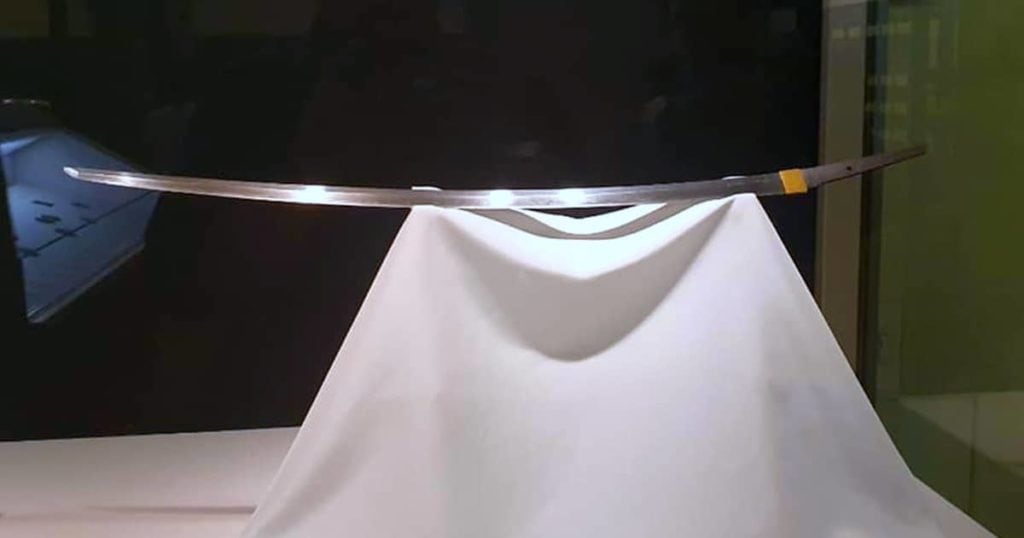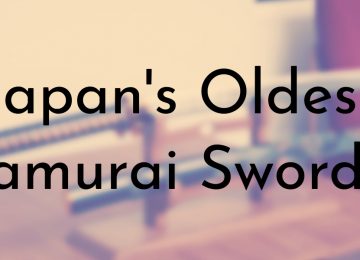The katana is the two-edged, straight sword traditionally worn in pairs by samurai. It is the symbol of courage and self-denial and is said to bring either good luck or bad luck depending on how it is treated.
There are many different representations of katanas, but they all adhere to the basic design principle: a blade with a curved tip that has been developed through years of refinement and innovation.
This article will discuss a very specific type of katana: the Japanese-inspired katana that has been adapted for use as a modern sporting weapon.
6. Mikazuki-munechika
Invented by: Sanjou Munechika
Year Made: 1185
Dynasty: Nanbokuchō period
Length: 105cm

This unique sword, Mikazuki Munechika, was created by the illustrious Sanjo Munechika. During the Heian era, he was regarded as one of Japan’s most accomplished swordsmiths. Because he loved it so much, Munechika gave his name and the Japanese word for “crescent moon,” “mikazuki,” to his invention.
Did You Know?
This sword is called the “Crescent Moon” because it contains symbols that resemble half-moons.
5. Onimaru
Invented by: Awataguchi Kunitsuna
Year Made: 1185
Dynasty: Edo period
Length: 78.2cm

Onimaru is a well-known historical Japanese katana. In addition to being one of the “Five Swords under Heaven,” it is considered a national treasure. A typical naming tradition for Japanese ships and swords is “maru,” which, although literally meaning “circle,” also signifies “devil.”
Did You Know?
Hojo Tokimasa had a dream about a demon and slayed it with his sword. After beating the demon, he never dreamed about it again, and the sword became Onimaru.
4. Muramasa
Invented by: Muramasa Sengo
Year Made: 1661
Dynasty: Tokugawa dynasty
Length: 66.4 cm

During feudal Japan, one of the most renowned swordsmiths was Muramasa Sengo. Throughout the Muromachi period, which lasted from the 14th to the 15th century AD, he dedicated his entire life to improving the art of sword-forging.
Following the aforementioned legend, several curses manifested. Some claim that the swords have a propensity to possess the person who wields them, sending them into a fury during combat.
The ability to temporarily possess superhuman strength and damage- and pain-immunity was also said to be imparted. In a final hypothesis, unparalleled swordsmanship was claimed to be bestowed by the sword on its user.
Did You Know?
Muramasa’s cursed swords were bloodthirsty. It causes the owner to commit suicide if not satisfied.
3. Uchigatana
Invented by: Unknown
Year Made: 1336
Dynasty: Japan’s Kamakura period
Length: 6 to 8 ft. long

The uchigatana served as the principal war blade from the Heian through the Muromachi periods. It was perfect for use while riding a horse because of its long blade and sharp edge. The uchigatana was first used in the fourteenth century, and its use extended throughout Japan throughout the Muromachi Period (1336–1573).
For a number of reasons, Uchigatana has gained popularity. First off, compared to a tachi, the uchigatana was shown to be more comfortable to wear and did not interfere as much with wielding a polearm.
Did You Know?
Unsheathing the uchigatana and slashing the adversary down with it became one fluid, lightning-fast movement, in contrast to the tachi, with which drawing the sword and striking with it were two separate operations.
2. Masamune
Invented by: Gorō Nyūdō Masamune
Year Made: 1288
Dynasty: Kamakura period
Length: 6 to 8 ft. long

Masamune, also known as Goro Nyudo Masamune, was a samurai who lived in an era when they rode into combat and met an honorable end. The story of Masamune has evolved into something of a myth because of his fabled conflict with his teacher Muramasa and the terrible loss of his work through time.
The first illustrious commander who acquired the Honjo Masamune sword gave it its name. In 1561, Honjo Shigenaga led his soldiers into combat at Kawanakajima. The general engaged in combat with a warrior of comparable rank, whose sword split Shigenaga’s helmet in two.
Did You Know?
There are still some Masamune artifacts around. Some of the items are in Japanese institutions, notably the Kyoto National Museum. Others are owned by Japanese private individuals. One sword can be seen in Austria’s Museum der Stadt Steyr.
1. Otenta-Mitsuyo
Invented by: Miike Denta Mitsuyo
Year Made: 1074
Dynasty: Muromachi period
Length: 66.1 cm

Otenta-Mitsuyo is the oldest katana in Japan. The moniker tenta (lit. “the Great Tenta”) derives from the name of the smith, which was inscribed in old sword papers and meikan records with various characters. tenta-Mitsuyo was one of the “Five Great Swords.”
The Maeda family named their product Tenta because they obviously intended to refer to the fabled ancestor of this lineage, despite the fact that other Mitsuyo smiths were active over the years.
According to a different version, the Maeda family may have had a different, shorter Mitsuyo blade that was known as Kotenta during the time.
Did You Know?
His sword was an Ashikaga shogunate relic. The sword was in the Maeda clan’s possession following the fall of the Ashikaga shogunate.











